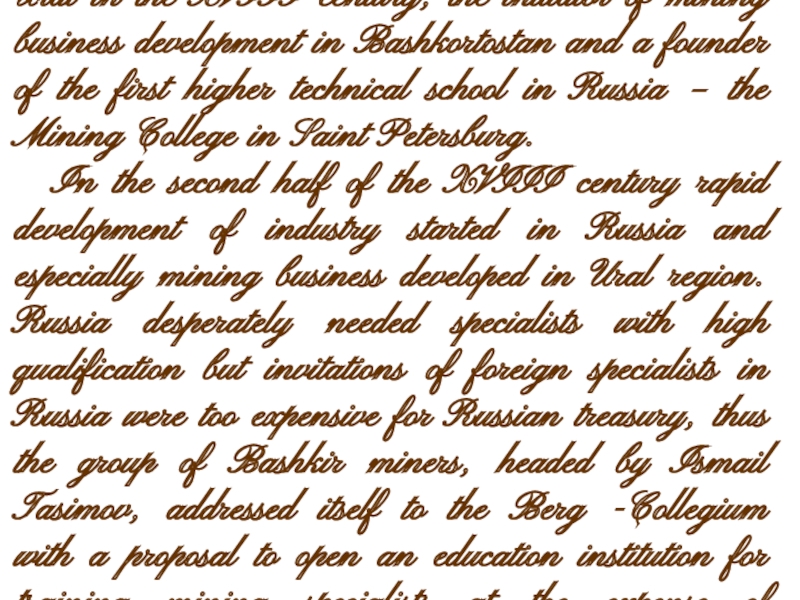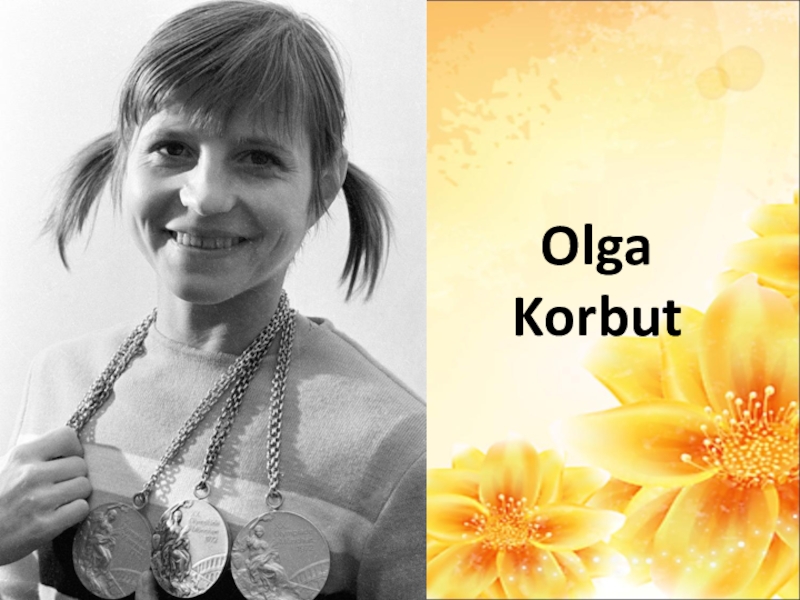- Главная
- Разное
- Образование
- Спорт
- Естествознание
- Природоведение
- Религиоведение
- Французский язык
- Черчение
- Английский язык
- Астрономия
- Алгебра
- Биология
- География
- Геометрия
- Детские презентации
- Информатика
- История
- Литература
- Математика
- Музыка
- МХК
- Немецкий язык
- ОБЖ
- Обществознание
- Окружающий мир
- Педагогика
- Русский язык
- Технология
- Физика
- Философия
- Химия
- Шаблоны, фоны, картинки для презентаций
- Экология
- Экономика
Презентация, доклад по английскому языку на тему Знаменитые личности Башкортостана (5 класс)
Содержание
- 1. Презентация по английскому языку на тему Знаменитые личности Башкортостана (5 класс)
- 2. Salavat Yulaev
- 3. Bashkir poet-improviser, the hero of liberation movement,
- 4. After the rebel defeat, he was sent
- 5. Ismail Tasimov
- 6. One of the most prominent mining engineers
- 7. He undertook to pay the percent from
- 8. Michael Nesterov
- 9. Is the famous Russian painter and public
- 10. Wishing to contribute to art education of
- 11. Rudolph Nuriev
- 12. The famous ballet dancer, who made the
- 13. In 1993 the memorial tablet was installed
- 14. The End
Salavat Yulaev
Слайд 3Bashkir poet-improviser, the hero of liberation movement, one of the leaders
during the Peasant War in 1773-1775, a fellow-fighter of Emelian Pugatchev.
In the course of the Peasant War, being in the rank of lieutenant colonel and further a brigadier, Salavat Yulaev supervised the key events of the Peasant War, formed rebellious squadrons, fought with governmental troops, besieged and seized fortresses and settlements and erected new administrative institutions in unfettered regions. There are the documents, which prove personal participation of Salavat Yulaev in more than 20 battles as well as the documents concerning his state-legal activity.
In the course of the Peasant War, being in the rank of lieutenant colonel and further a brigadier, Salavat Yulaev supervised the key events of the Peasant War, formed rebellious squadrons, fought with governmental troops, besieged and seized fortresses and settlements and erected new administrative institutions in unfettered regions. There are the documents, which prove personal participation of Salavat Yulaev in more than 20 battles as well as the documents concerning his state-legal activity.
Слайд 4After the rebel defeat, he was sent to penal servitude for
life to the fortress of Rogerwick (now Estonia, the town of Paldiski). He died in 1800.
Salavat Yulaev literary heritage includes more than 500 poetic works about struggle with oppressors, native land, Bashkir people and love for a woman. The image of Salavat Yulaev is commemorated in works of many Russian nations.
In 1967, the Monument of Salavat Yulaev by the sculptor Tavasiev was opened in Ufa. The monument is considered the highest horse statue in Russia with nearly ten metres at height. The monument’s image can be found on Bashkortostan emblem. The avenue in Ufa, the city of Salavat and the local hockey club are named after him.
Salavat Yulaev literary heritage includes more than 500 poetic works about struggle with oppressors, native land, Bashkir people and love for a woman. The image of Salavat Yulaev is commemorated in works of many Russian nations.
In 1967, the Monument of Salavat Yulaev by the sculptor Tavasiev was opened in Ufa. The monument is considered the highest horse statue in Russia with nearly ten metres at height. The monument’s image can be found on Bashkortostan emblem. The avenue in Ufa, the city of Salavat and the local hockey club are named after him.
Слайд 6One of the most prominent mining engineers of Ural in the
XVIII century, the initiator of mining business development in Bashkortostan and a founder of the first higher technical school in Russia – the Mining College in Saint Petersburg.
In the second half of the XVIII century rapid development of industry started in Russia and especially mining business developed in Ural region. Russia desperately needed specialists with high qualification but invitations of foreign specialists in Russia were too expensive for Russian treasury, thus the group of Bashkir miners, headed by Ismail Tasimov, addressed itself to the Berg -Collegium with a proposal to open an education institution for training mining specialists at the expense of Bashkirs.
In the second half of the XVIII century rapid development of industry started in Russia and especially mining business developed in Ural region. Russia desperately needed specialists with high qualification but invitations of foreign specialists in Russia were too expensive for Russian treasury, thus the group of Bashkir miners, headed by Ismail Tasimov, addressed itself to the Berg -Collegium with a proposal to open an education institution for training mining specialists at the expense of Bashkirs.
Слайд 7He undertook to pay the percent from the incomes, obtained from
mining business, in favour of the institution. The Senate and Katherine the Empress approved this proposal. In 1778-1781, Bashkir miners collected 4 thousand 594 roubles 93 kopecks for the maintenance of the newly founded college.
At present time the Mining College, founded by Ismail Tasimov, is called Saint-Petersburg Mining Academy. In 2007, it was decided to commemorate his name and to install a memorial tablet on the wall of the Academy.
At present time the Mining College, founded by Ismail Tasimov, is called Saint-Petersburg Mining Academy. In 2007, it was decided to commemorate his name and to install a memorial tablet on the wall of the Academy.
Слайд 9Is the famous Russian painter and public activist. He is considered
one of the brightest representatives of Christian art in XIX – XX centuries. He was born in Ufa in 1862 in a merchant’s family. Michael Nesterov began to study drawing at Ufa Gymnasium. Later he studied in Moscow, at the College of painting, sculpture and architecture. V.G Perov and I.N. Kramskoy were his pedagogues. The talent of Nesterov as an icon-painter became especially apparent in the course of painting the Vladimir’s Church in Kiev. Continuing the traditions of ancient Russian painting Nesterov created really pathetic images of the Savoir, the Godmother and other saints.
Слайд 10Wishing to contribute to art education of his compatriots Nesterov presented
the collection of Russian fine arts of the second half of the XIX – the beginning of the X centuries to his native town – Ufa – in 1913. In a whole Ufa received 102 works, including canvasses of Repin, Shishkin, Makovsky, Korovin, Yaroshenko, Polenov, Levitan and others. After October Revolution 1917, Nesterov proved himself as a great master of psychological portrait. In 1942, he was rewarded with the rank of honourable painter RF.
The Bashkir Arts Museum – one of the oldest regional museums of Russia – was opened in 1920. Now the Nesterov Bashkir State Arts Museum works in Ufa.
The Bashkir Arts Museum – one of the oldest regional museums of Russia – was opened in 1920. Now the Nesterov Bashkir State Arts Museum works in Ufa.
Слайд 12The famous ballet dancer, who made the whole world to admire
the ballet art again. He was born on April 17, 1938, in the train on the way to Irkutsk. The artist through all his life kept his love for travelling. The metaphor of eternal movement, which was the base of his being, was incarnated in his dances.
For the first time Rudolph Nureyev saw the ballet art in Ufa, when he was six – at Bashkir State Theatre of Opera and Ballet, the performance “The Crane Song”, with Zaituna Nasretdinova starring, whom Nureyev regarded the best national ballet-dancer till the end of his life.
Ufa Choreographic College is located at Ufa school N2, where Rudolph Nureyev studied.
For the first time Rudolph Nureyev saw the ballet art in Ufa, when he was six – at Bashkir State Theatre of Opera and Ballet, the performance “The Crane Song”, with Zaituna Nasretdinova starring, whom Nureyev regarded the best national ballet-dancer till the end of his life.
Ufa Choreographic College is located at Ufa school N2, where Rudolph Nureyev studied.
Слайд 13In 1993 the memorial tablet was installed there with such words:
“The prominent ballet-dancer of the XX century Rudolph Nureyev started his splendid way on this stage in 1953-1955”.
For his 30-years career Rudolph Nureyev played more than 100 parts, he worked with 40 world troupes and staged practically all classical ballets (“The Swan’s Lake”, “Raimonda”, “The Nutcracker” etc) and produced new ballets (“Cinderella”, “The Storm” and others).
In 1961, touring with his theatre in Paris, Nureev requested a political asylum. Then he played at London’s “Royal Ballet”, in the ballet troupe of Chicago Opera and was the head of the ballet troupe of Paris Opera.
He died in 1993 and was buried near Paris at the cemetery of Sainte-Genevieve-des-Bois.
For his 30-years career Rudolph Nureyev played more than 100 parts, he worked with 40 world troupes and staged practically all classical ballets (“The Swan’s Lake”, “Raimonda”, “The Nutcracker” etc) and produced new ballets (“Cinderella”, “The Storm” and others).
In 1961, touring with his theatre in Paris, Nureev requested a political asylum. Then he played at London’s “Royal Ballet”, in the ballet troupe of Chicago Opera and was the head of the ballet troupe of Paris Opera.
He died in 1993 and was buried near Paris at the cemetery of Sainte-Genevieve-des-Bois.



















